LVMH Prize Finalists: This Is What the Future of Menswear Looks Like
Since it launched in 2013, the LVMH Prize has become a key source for breaking new talent into the fashion industry, where a core group of designers make up what can seem like an impenetrable pantheon. Through the program, which awards a winner 300,000 euros and mentoring and support from industry insiders and LVMH brass, the world has come to know talents like Marine Serre, who won in 2017, and Grace Wales Bonner, who won the year before. It’s more than a decorative honor: for young designers, who face more hurdles than ever to establish their businesses beyond initial buzz, the prize is also a significant resource, material and otherwise.
This year’s eight finalists, whittled down from a group of twenty, include a particularly strong group of menswear designers: Nicholas Daley, whose eponymous line of elegant, freaky sportswear and tailoring is beloved by East London’s jazz scene; Priya Ahluwalia, who designs sharp and global streetwear under the label Ahluwalia; and Charaf Tajer, of the Paris-based granny-chic brand Casablanca.
The prize’s usual series of events during Paris Fashion Week in March was contracted due to the spread of coronavirus, but the program nonetheless managed to mount its showcase, in which designers presented their work to a handful of the judges. Pandemic worries aside—explaining his work to “Anna Wintour and Gigi Hadid and all these high profile individuals,” Daley says, “ was already quite an overwhelming experience.”
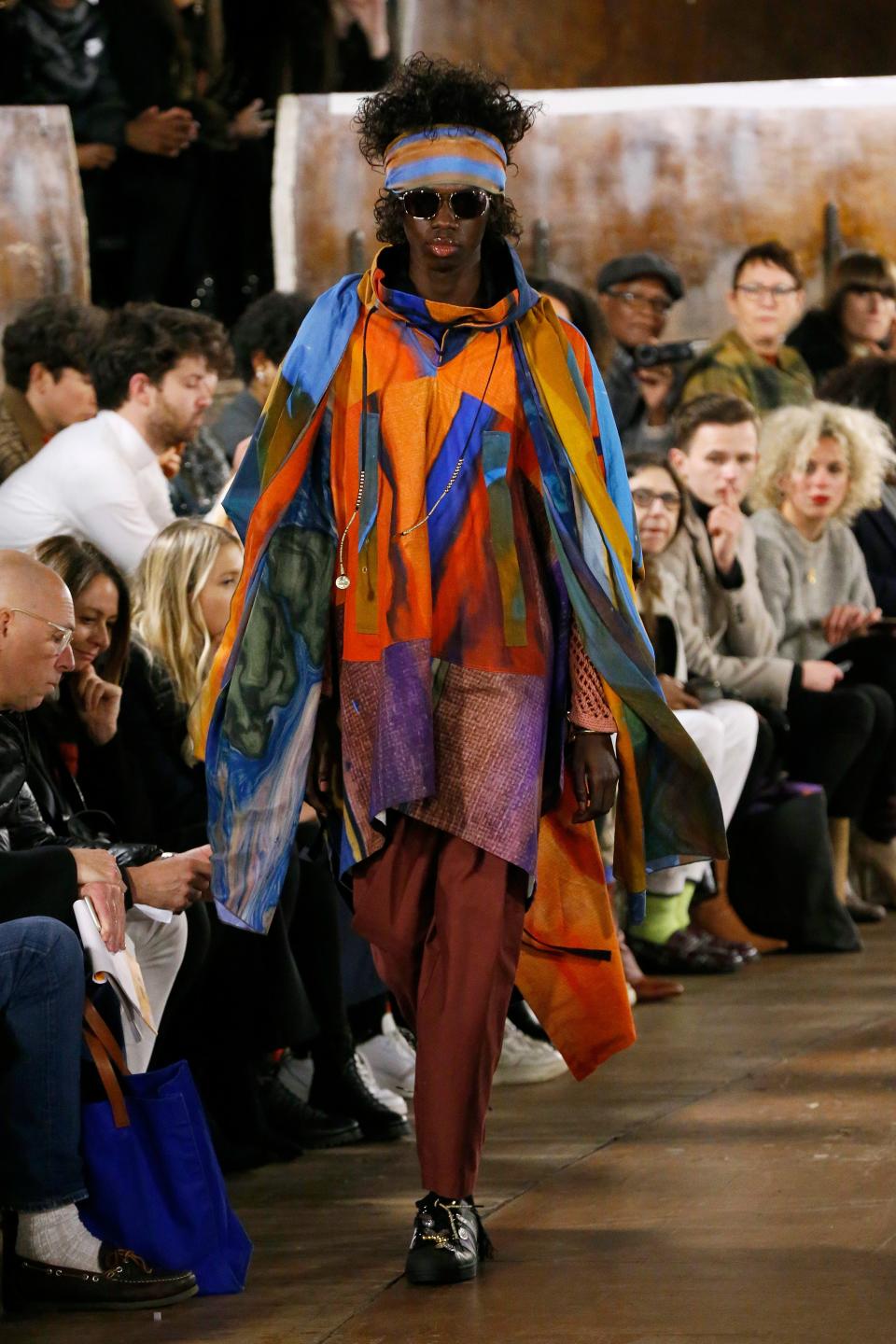
Nicholas Daley - Runway - LFWM January 2020
The panel of judges assembled for June’s final presentations includes an intimidating lineup of talent, like Marc Jacobs, Virgil Abloh, Jonathan Anderson, and—literally—Rihanna. “You could work in this industry for 50 years and never get to meet these people,” Ahluwalia says. “When I was in uni, getting my B.A., I used to [follow the prize], but I never thought at the time that I’d be in it.”
All three of these designers are making work that represents the next generation of menswear: it’s characterized by an investment in subculture and community. Their forebears elevated street influences and sportswear to fashion’s highest echelons, and these young talents bring to that foundation an obsession with technique and polish—in other words, a new sophistication.
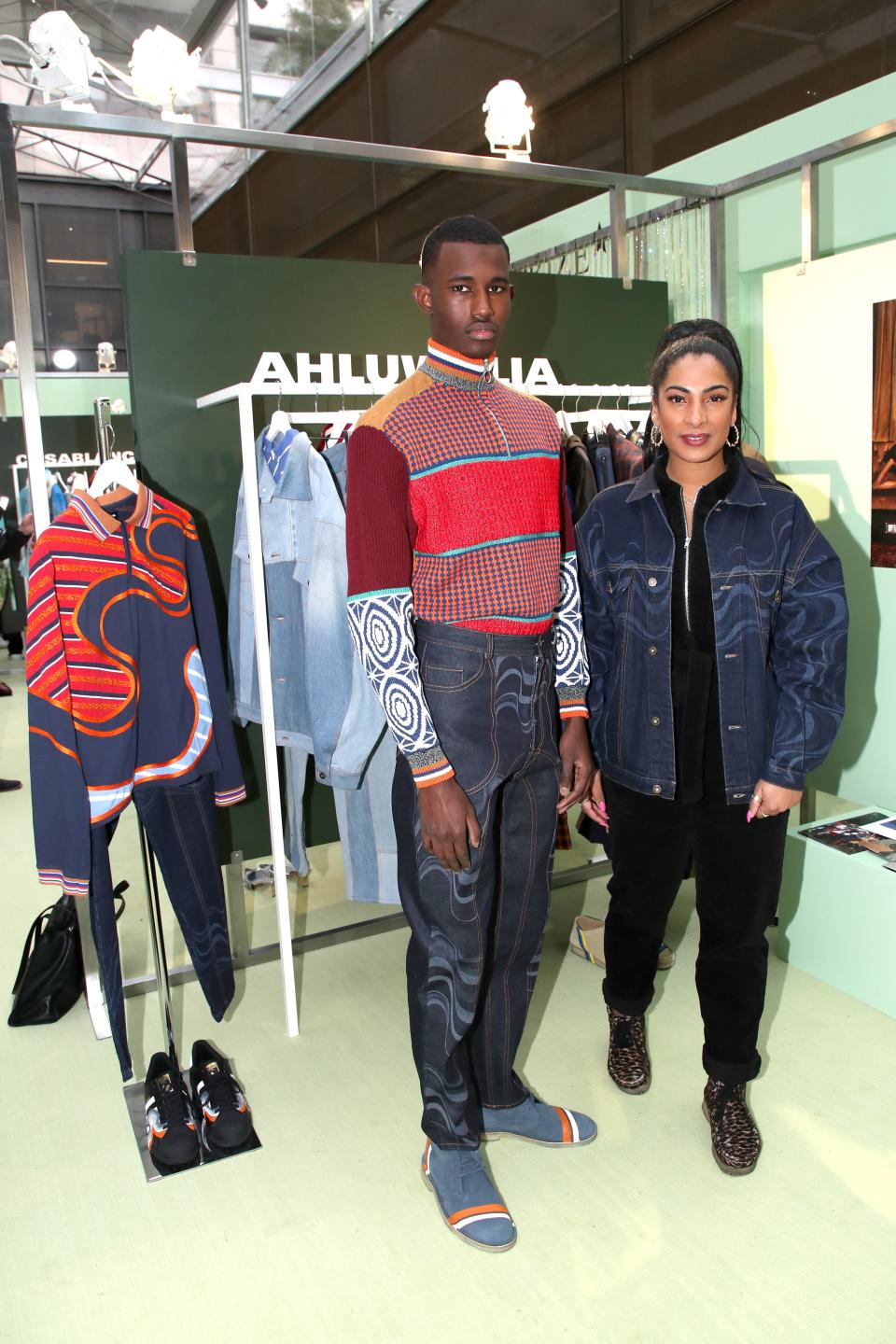
LVMH Prize Presentation
Over the past week, I connected with the designers to discuss their brands and hopes for the competition; inevitably, our conversations also drifted to how the coronavirus might affect their business and how they might need to rethink or adapt their creative processes. “I think right now people are really scared,” Ahluwalia says. “Some stores aren’t ordering for Fall 2020. People are being really cautious. To be honest, it has already really affected [business].”
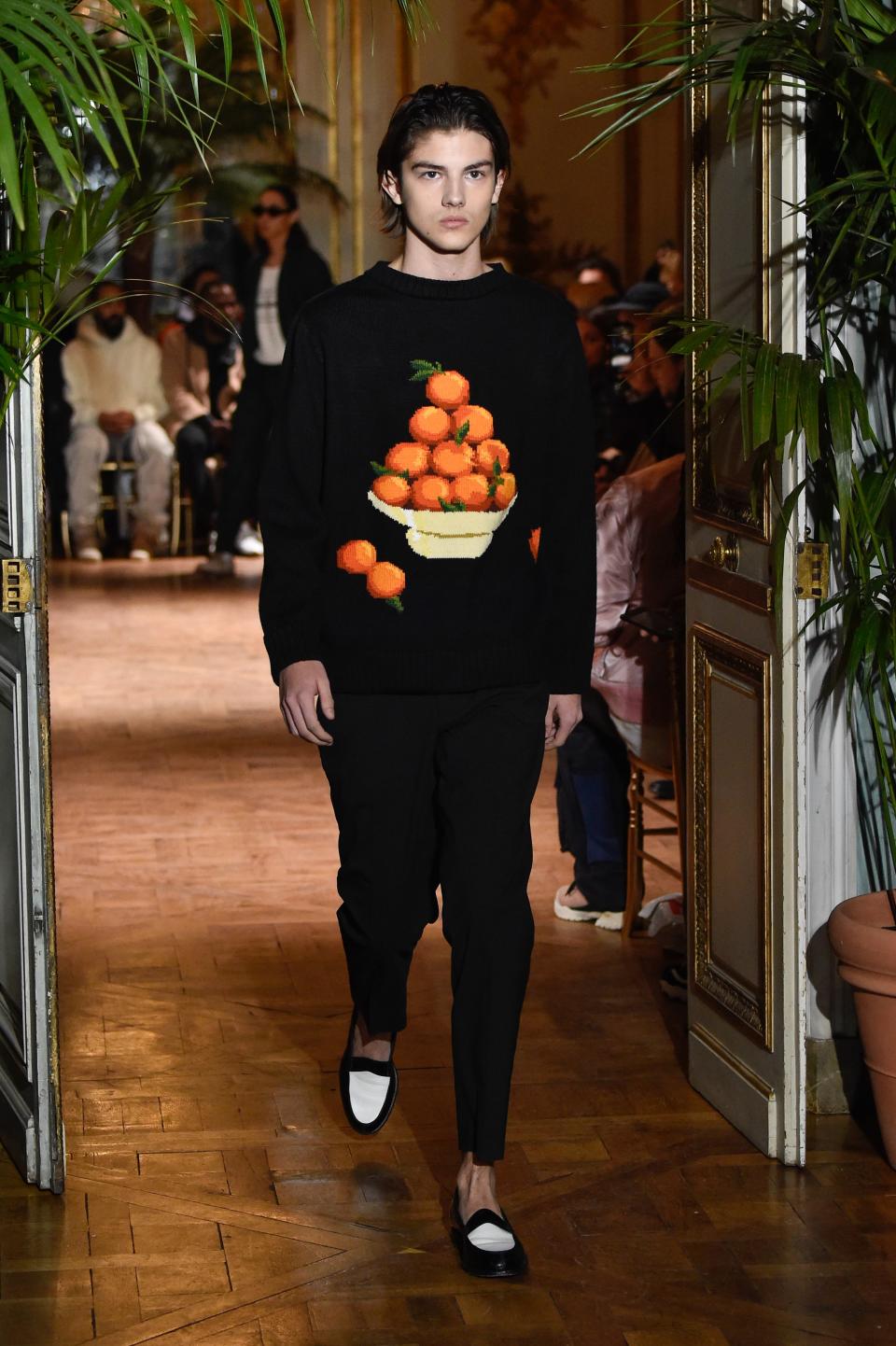
Casablanca : Runway - Paris Fashion Week - Menswear F/W 2019-2020
As of this publication, LVMH has not announced plans to change the schedule for the prize—it’s meant to be awarded on June 5th. But if a postponement or cancellation does happen, the designers seem unflappable—one of the benefits of being young and visionary. “Health is wealth, at the end of the day!” Ahluwalia says cheerily.
Priya Ahluwalia, Ahluwalia
Upcycling, or the use of deadstock or vintage fabrics reworked into new clothing, has become a kind of buzzword as the industry finds itself eager to trumpet sustainability efforts. “I actually hate that word, you know?” she says in her energetic clip, when reached by phone in London. “Because it’s got such bad connotations. It sounds like a Pinterest project.”
She prefers words like repurpose, or rework. “At the end of the day, I want the business to be seen as a high-fashion brand,” she says. “I don’t think ‘upcycling’ really fits that. It sounds so crafty, rather than artisanal.” There’s no sense that she’s ‘making do’ with old materials, which is a problem designers often face with upcycling, as they find themselves integrating fabrics and prints that can be decidedly retro into their designs.
There’s certainly nothing crafty about Ahluwalia’s clothes, which are sharp, crisp, and vivacious. “I would say that it’s really quite bold, graphic, multi-layered,” she says. Her Fall 2020 collection includes trucker-jacket suits with slightly far-out, patched-in prints (there are those repurposed fabrics!) as well as parkas, trackpants, shorts, and sporty blouses printed with a wave design.
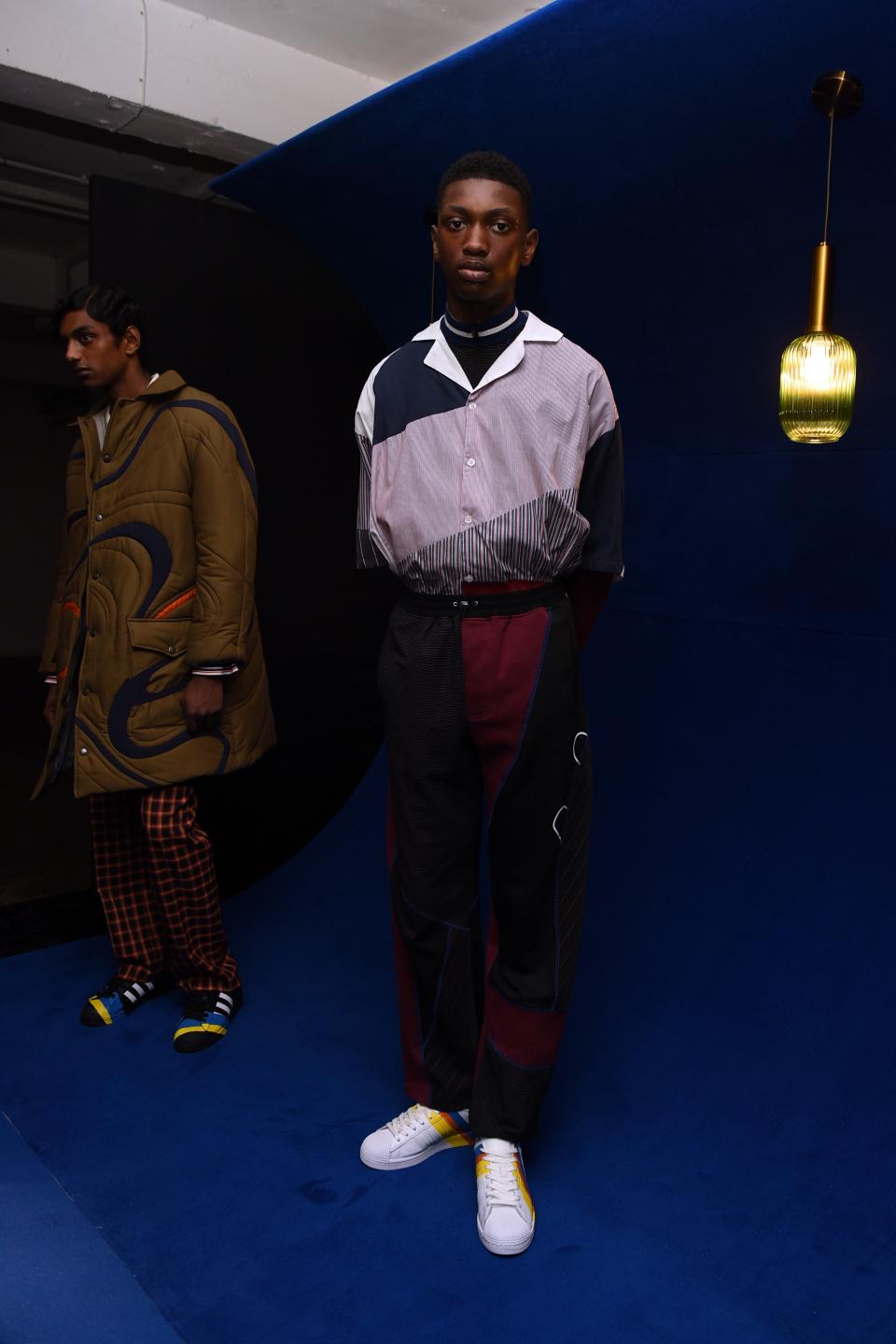
Ahluwalia Studio - DiscoveryLAB - LFWM January 2020
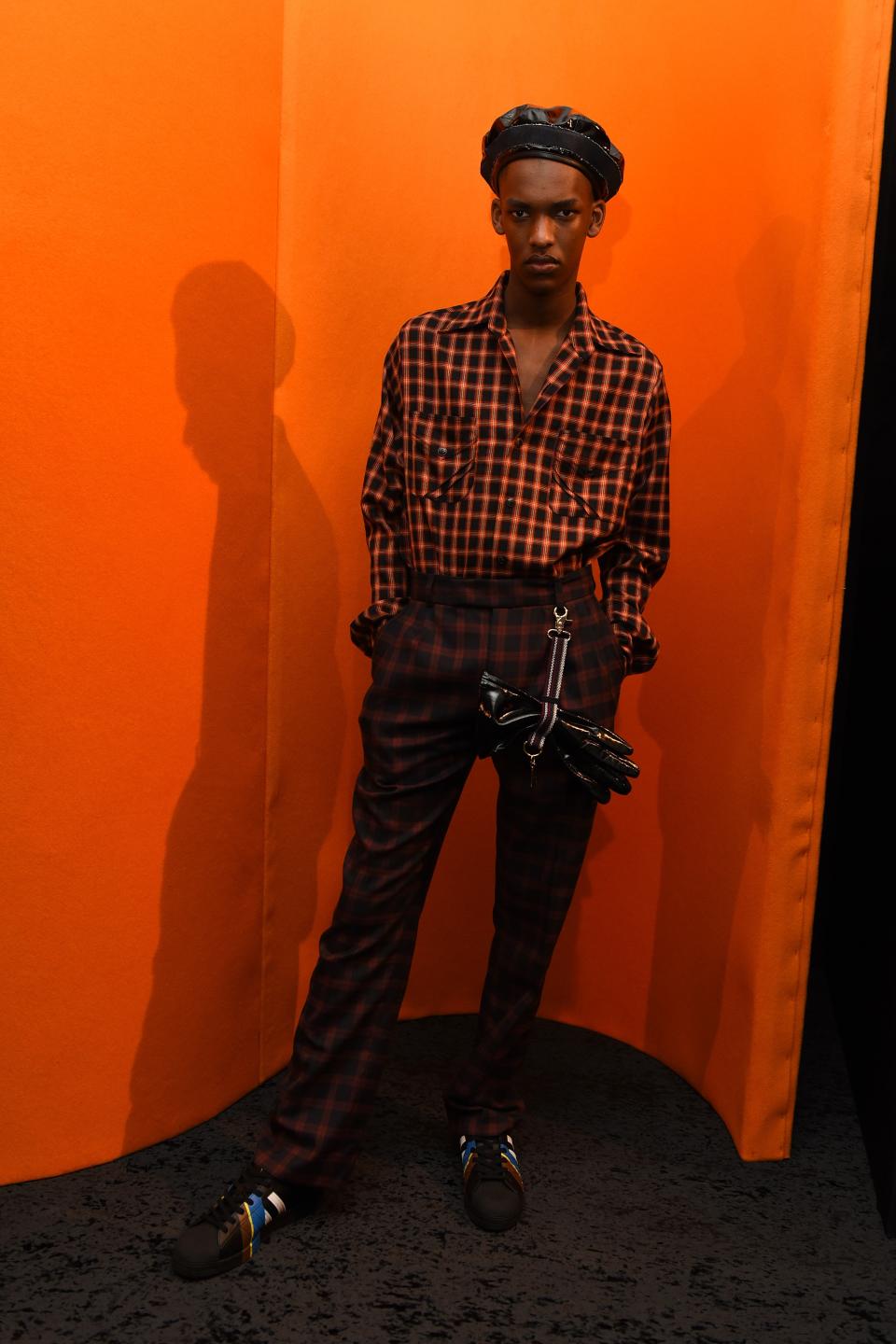
Ahluwalia Studio - DiscoveryLAB - LFWM January 2020
Ahluwahlia’s collections are always somewhat autobiographical—raised in London, she has Indian and Nigerian roots—and she’s made playful talismans, like gloves hanging from lanyards, and prints out of photographs of her family. If a lot of young designers have a gentle and emotional touch, making clothing as a kind of comfort against the chaotic world they grew up in, there is a kind of sparky, almost aggressive joy to what she does.
She took 1965, the year of her stepfather’s birth, as a starting point for her most recent show, but there’s no vintage feel, or sense that she’s invested in recreating a moodboard of worn photographs, which has been a throughline from her first collection, Spring 2019. It’s assertively modern. “I design things because I think they’re going to be desirable and interesting to look at,” she says. “And as a designer I start with thinking, how can I source this in the best way I can? It doesn’t start ever with ‘vintage’ or that kind of clothing. It’s not the inspiration, and it’s not what leads the design process.”
For past collections, Ahluwalia has sourced fabrics from Tunisia and made her beading ethically by partnering with the Indian women’s union SEWA Dehli, though she acknowledges that the pandemic will make that kind of globalized designing difficult. “I can always source materials from the U.K.,” she says. In that way, her approach to fashion reflects certain realities about any given moment in the world that other designers might ache to articulate.
Nicholas Daley
Nicholas Daley has had a kind of cult following since he launched his brand in 2015—it comes with a built-in community, after all, but more on that in a minute. His Fall 2020 collection, shown in London in January, felt like a giant leap ahead, with a technical panache and a new sense of passion. This was his last show with the British Fashion Council’s NEWGEN program, where he’s been showing for two years, and he went out with a bang. “I was definitely trying to elevate everything, from the venue itself, to the size of the collection, to integrating all of the collaborations,” like suave gym bags and tracksuits done with Fred Perry, hulky loafers by Trickers, and a coin-draped Adidas Superstar.
When a good designer puts their all into a collection, you can see it in every little detail—here, in the refined shapes, the baker boy caps, the fluidity between the prints, the harmony between his mainline and those collaborative pieces, and even in the casting and hairstyling—but you can also just feel something is up when you look at good clothes.
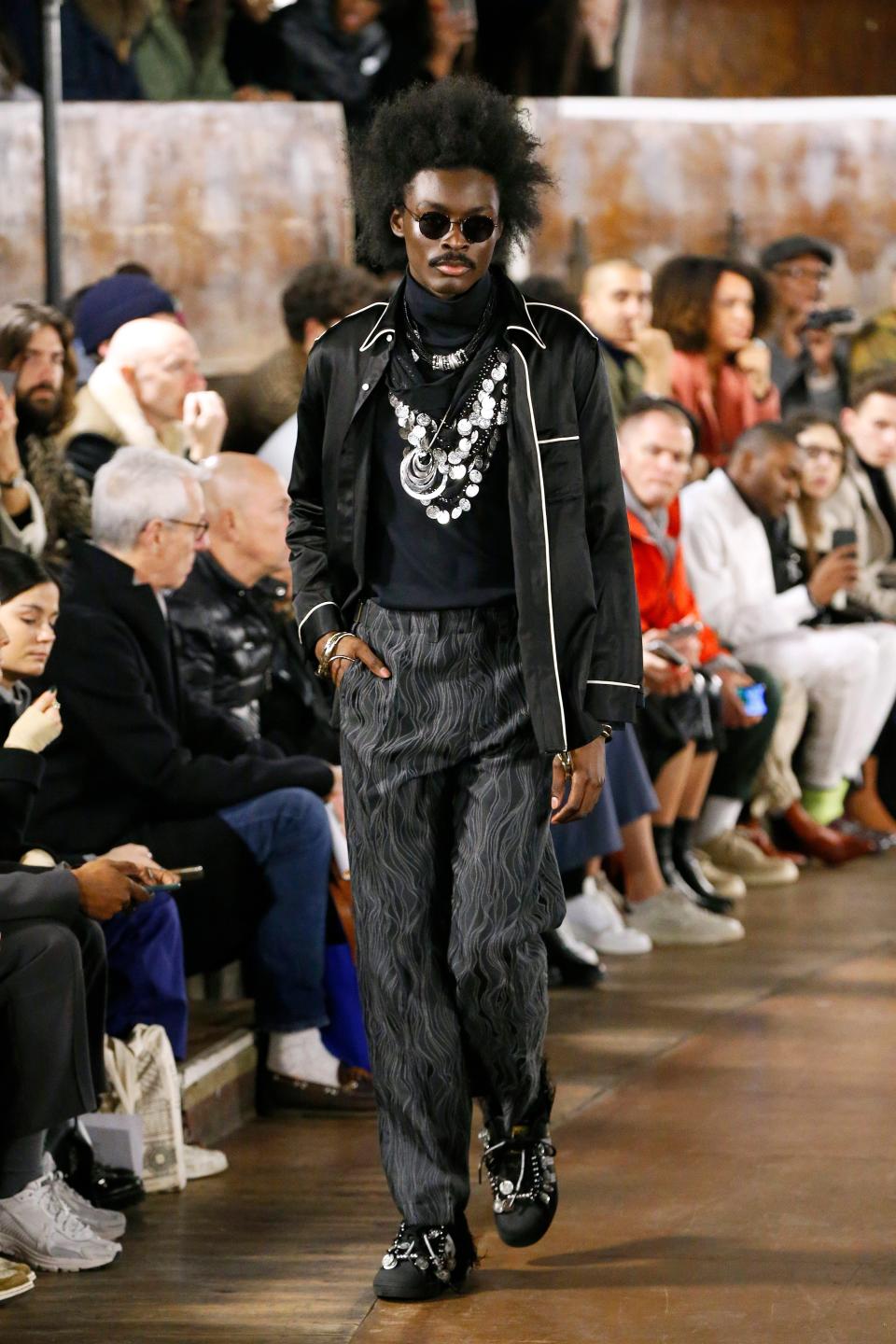
Nicholas Daley - Runway - LFWM January 2020
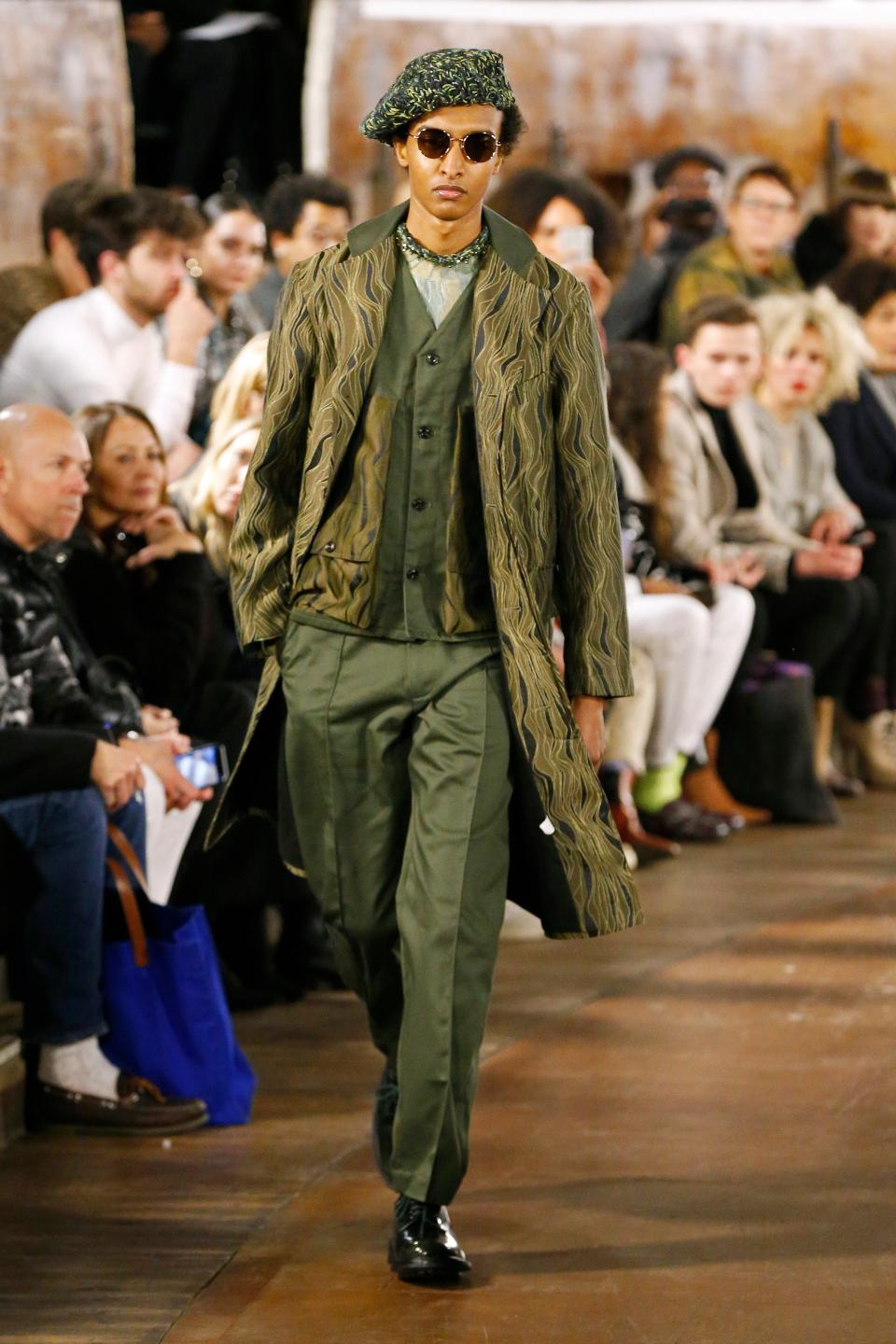
Nicholas Daley - Runway - LFWM January 2020
It’s a little bit like music, which happens to be an integral part of Daley’s vision. The show, held in the storied, 1000-capacity East London club Earth, was part of a full night of programming, with a reggae sound system, and London DJs like rapper Rago Foot and virtuoso drummer Kwake Bass. “It was absolutely rammed and super sweaty, but that’s how it should be,” Daley says. The late Central Saint Martins professor Louise Wilson used to say that designers should start by making clothing for and dressing their friends, and that even as they expand their clientele, that that original group of friends “reflect something.” Daley feels like one of the first designers in a long time to nail that trajectory, with a community of musicians coalescing around him and infusing their energy into the clothes. “I felt it was really important, as a designer, as a creative person on this planet, to celebrate and appreciate the things we care about,” he says.
From a design standpoint, Daley has also pushed himself to have “more of a variety in the textiles and fabrications,” like mohair checks by Scottish tartan maker Loch Carron and Japanese tie-dye techniques. The mix of textures and source material—physical and emotional—made it feel at once more autobiographical and more original, more of a statement. “Like all creative professions, you develop and grow, and try new things. And it’s also what would it mean, being an independent, emerging brand. I’ve always tried to do things at a pace that is realistic, whether that be collaborations with Fred Perry, or trying new techniques in Japan,” he says. “I’ve just tried to expand my creative output, and I think that’s where the development occurred.”
Charaf Tajer, Casablanca
Charaf Tajer started Casablanca in 2019 with strong Paris cult menswear credentials, after designing at Pigalle and co-founding the nightclub Le Pompon. But Casablanca is a vision all his own. His Fall 2020 collection was an exuberant, feminine expression of menswear, featuring prints both cartoonish—a dalmatian hopping across a pair of bell bottoms—and painterly, like a flying swan and luxurious arrangements of fruit. But the standout pieces looked like they were borrowed from the closet of a chic grandparent, like flowing trousers, and soft, cardigan-style suiting jackets with a Chanel-like poshness. “We need to bring beauty and love into menswear,” he told Vogue after that show. “I think there is too much irony everywhere. I think we should just go for it.”
His ancestral nods—which fit seamlessly into a larger trend of men dressing with grandmotherly abandon—feel at once personal and global. Wearing tailored clothing under fur-collared mod coats seems no more demanding than wearing a tracksuit tracksuits, and Tajer paired both with zesty green sneakers from a New Balance collaboration. “I would say this is the grandpa style. It’s the grandpa shoe, like the cool Italian grandad shoe,” he told Complex.
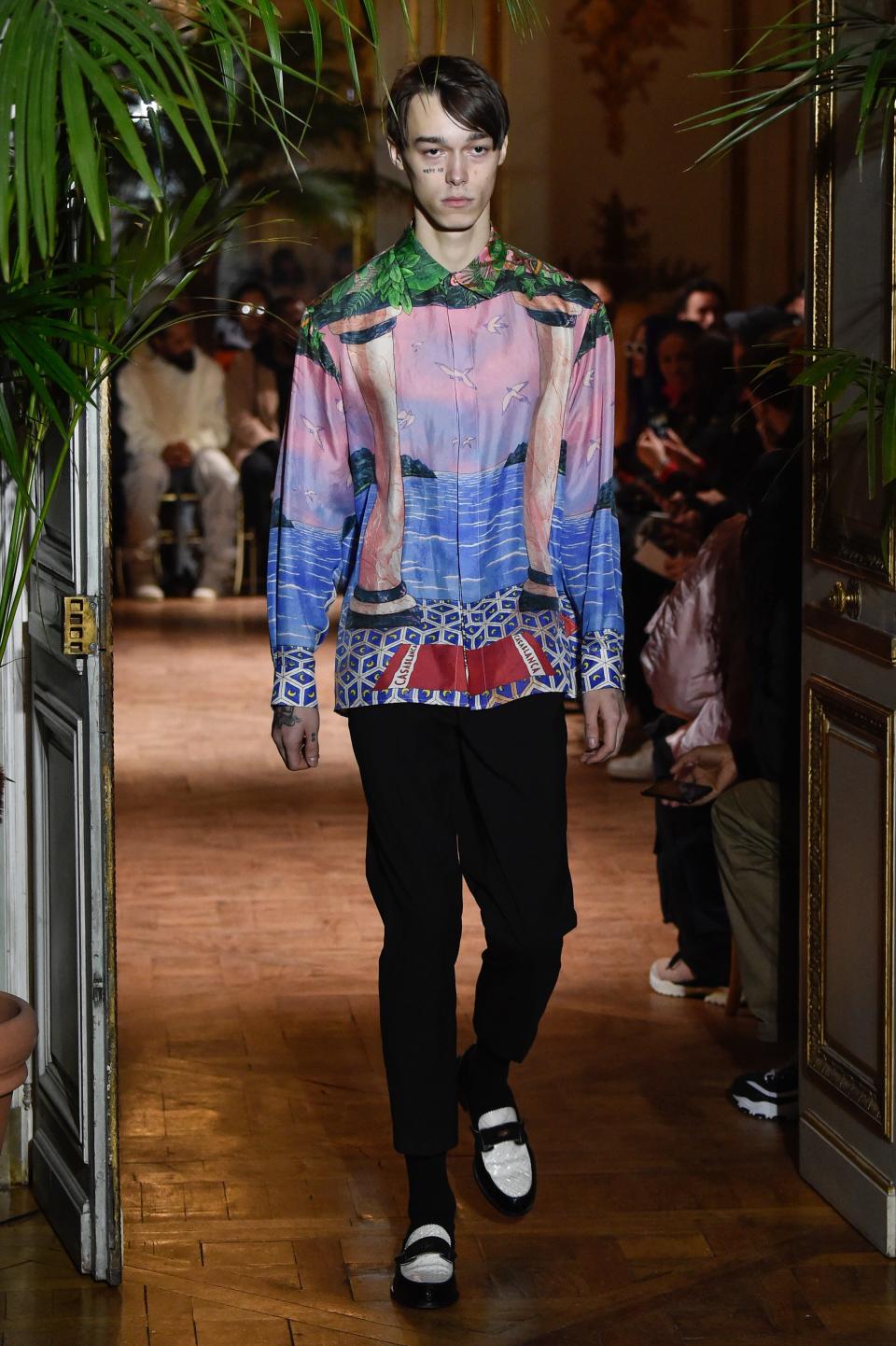
Casablanca : Runway - Paris Fashion Week - Menswear F/W 2019-2020
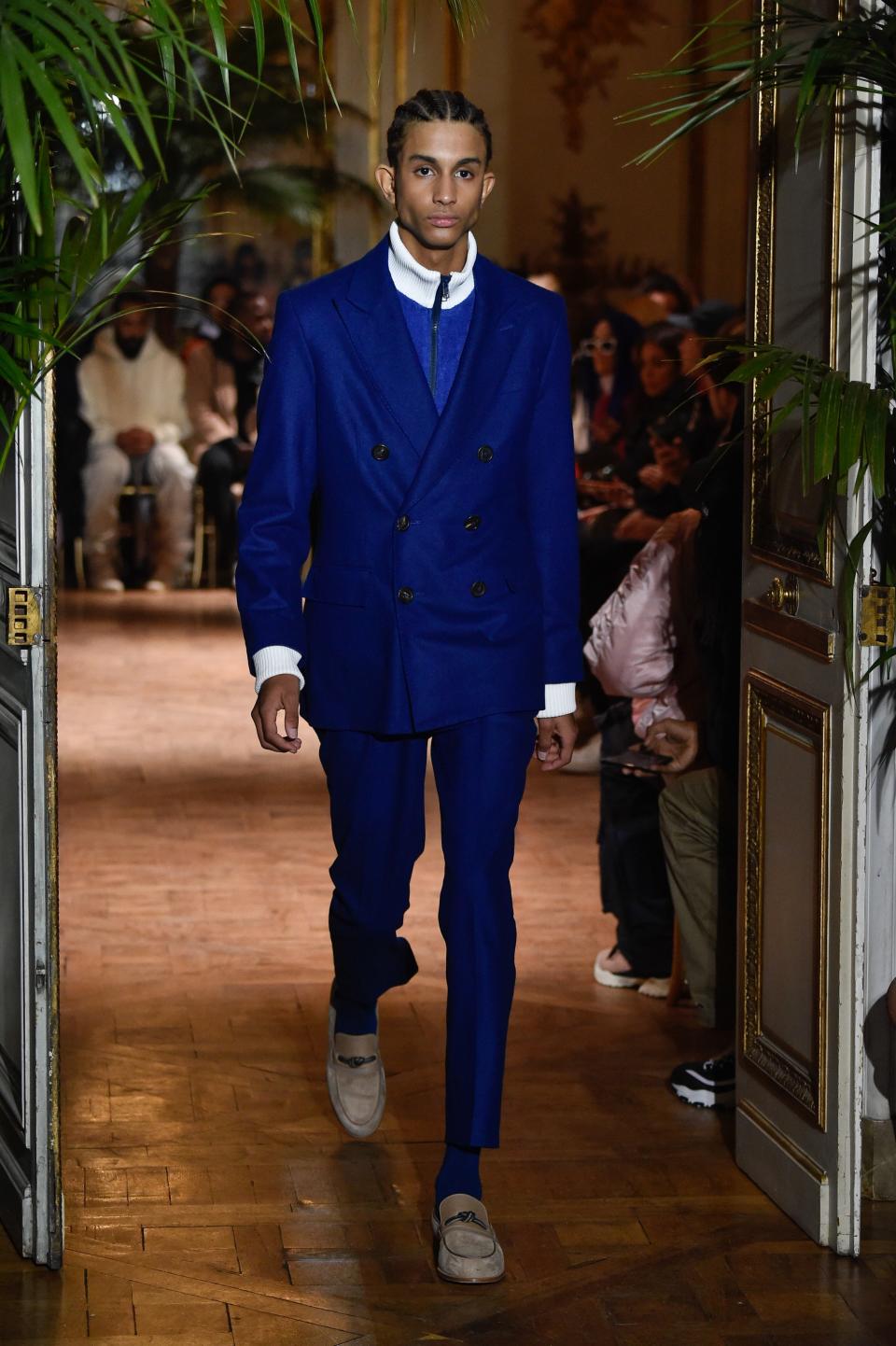
Casablanca : Runway - Paris Fashion Week - Menswear F/W 2019-2020
His clothes may seem like they are only for the very bold—a printed suit that looks inspired by Tajer’s native Morocco, with a flowing silk scarf knotted around the neck—but the flash is executed with the ease of sports clothing. “You can be feminine but very strong at the same time,” he told Vogue. “It’s not a weakness.”
Originally Appeared on GQ

